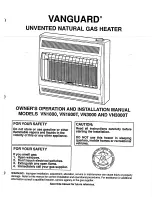
331551-002
– 15 –
Installation Of Power Venter
The current edition of
“Standard for the Installation of
Oil-Burning Equipment (NFPA 31)”
, local codes and the
manufacturer's instructions should be adhered to in all
installations of the water heaters and power venters. A draft
regulator must be used in conjunction with the installation
of the power venter (see "Draft Regulator"). Consult the
applicable codes to calculate the equivalent length of pipe for
each fitting in the vent system. Add this (equivalent) length to
the length of the straight runs of pipe to determine the total
equivalent vent pipe length.
CK SERIES
CONTROL KIT
DRAFT
REGULATOR
OIL FIRED
WATER
HEATER
SWG II 4HD
POWER
VENTER
SEE "Draft Regulator"
Figure 8. Power Venting
Water Supply
This appliance has been design certified as complying with
CSA Standard for water heaters and is considered suitable
for Water (Potable) Heating and Space Heating.
The water heater should not be subjected to excessive
water pressure fluctuations and should not be subjected to
an operating pressure greater than 80 psi. If this occurs, a
pressure-reducing valve with a bypass should be installed in
the cold-water inlet line. This should be placed on the supply
to the entire house in order to maintain equal hot and cold
water pressure.
•
Avoid water heater damage.
•
Install thermal expansion tank if necessary.
•
Do not apply heat to cold-water inlet or hot-water outlet.
•
Contact qualified installer or service agency.
Property Damage Hazard
CAUTION
Piping Installation
Piping, fittings, and valves should be installed according to
the applicable installation drawing (Figure 9 and Figure 10).
A pressure-reducing valve and/or an expansion tank may be
required for installations where the water pressure is high.
The pressure-reducing valve should be located on the supply
to the entire house in order to maintain equal hot and cold
water pressure.
Important:
•
Do not apply heat to the water fittings on the heater as
they may contain nonmetallic parts. If solder connections
are used, solder the pipe to an adaptor before attaching
the adaptor to the hot and cold water fittings.
•
Some models may contain energy saving heat traps to
prevent the circulation of hot water within the pipes. Do
not remove the inserts within the heat traps.
•
Always use a proper grade of joint compound and be
certain that all fittings are drawn up tight.
1. Install the water piping and fittings as shown in Figure 9 or
Figure 10. Connect the cold water supply to the unmarked
fitting (3/4” NPT). Connect the hot water supply to the
fitting (3/4” NPT) marked “HOT” (or “H”).
2. The installation of unions in both the hot and cold water
supply lines is recommended.
3. The manufacturer of this water heater recommends
installing a tempering valve in the domestic hot water line.
These valves reduce the point-of-use water temperature
by mixing cold and hot water. Contact a licensed plumber
or the local plumbing authority.
Note:
For water heaters intended for household use, a
thermostatically controlled tempering valve meeting the
requirements of CSA B125 or ASSE 1016 or 1017 should
be used to temper the domestic hot water supply to fixtures
to 120°F .
4. If installing the water heater in a closed water system,
install an expansion tank in the cold water line as specified
under "Closed System/Thermal Expansion".














































